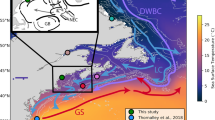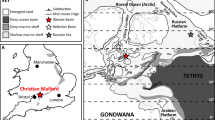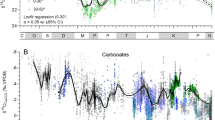Abstract
Climate models with increased levels of carbon dioxide predict that global warming causes heating in the tropics, but investigations of ancient climates based on palaeodata have generally indicated cool tropical temperatures during supposed greenhouse episodes. For example, in the Late Cretaceous and Eocene epochs there is abundant geological evidence for warm, mostly ice-free poles, but tropical sea surface temperatures are generally estimated to be only 15–23 °C, based on oxygen isotope palaeothermometry of surface-dwelling planktonic foraminifer shells. Here we question the validity of most such data on the grounds of poor preservation and diagenetic alteration. We present new data from exceptionally well preserved foraminifer shells extracted from impermeable clay-rich sediments, which indicate that for the intervals studied, tropical sea surface temperatures were at least 28–32 °C. These warm temperatures are more in line with our understanding of the geographical distributions of temperature-sensitive fossil organisms and the results of climate models with increased CO2 levels.
This is a preview of subscription content, access via your institution
Access options
Subscribe to this journal
Receive 51 print issues and online access
$199.00 per year
only $3.90 per issue
Buy this article
- Purchase on Springer Link
- Instant access to full article PDF
Prices may be subject to local taxes which are calculated during checkout





Similar content being viewed by others
References
Urey, H. C. The thermodynamic properties of isotopic substances. J. Chem. Soc. 1947, 562–581 (1947).
Emiliani, C. Depth habitats of some species of pelagic foraminifera as indicated by oxygen isotope ratios. Am J. Sci. 252, 149–158 (1954).
Crowley, T. J. & Zachos, J. C. in Warm Climates in Earth History (eds Huber, B. T., MacLeod, K. S. & Wing, S. C.) 50–76 (Cambridge Univ. Press, Cambridge, 2000).
Spero, H. J., Bijma, J., Lea, J. W. & Bemis, B. E. Effect of seawater carbonate chemistry on planktonic foraminiferal carbon and oxygen isotope values. Nature 390, 497–500 (1997).
Schrag, D. P., DePaolo, D. J. & Richter, F. M. Reconstructing past sea surface temperatures: Correcting for diagenesis of bulk marine carbonate. Geochim. Cosmochim. Acta 59, 2265–2278 (1995).
Schrag, D. P. Effects of diagenesis on the isotopic record of late Paleogene tropical sea surface temperatures. Chem. Geol. 161, 215–244 (1999).
Shackleton, N. J. & Boersma, A. The climate of the Eocene ocean. J. Geol. Soc. Lond. 138, 153–157 (1981).
Savin, S. M. The history of earth's surface temperature during the past 100 million years. Annu. Rev. Earth Planet. Sci. 5, 319–355 (1977).
Shackleton, N. J. in Fossils and Climate (ed. Brenchley, P.) 27–34 (Wiley, Chichester, 1984).
Barron, E. J. Eocene equator-to-pole surface ocean temperatures: a significant climate problem? Paleoceanography 2, 729–739 (1987).
Rind, D. & Chandler, M. Increased ocean heat transports and warmer climate. J. Geophys. Res. 96, 7437–7461 (1991).
Horrell, M. A. Energy balance constraints on 18O based paleo-sea surface temperature estimates. Paleoceanography 5, 339–348 (1990).
Manabe, S. & Bryan, K. CO2-induced change in a coupled ocean-atmosphere model and its paleoclimatic implications. J. Geophys. Res. 90, 11689–11708 (1985).
Sloan, L. C. & Rea, D. K. Atmospheric carbon dioxide and early Eocene climate: A general circulation model sensitivity study. Palaeogeogr., Palaeoclimatol. Palaeoecol. 119, 275–292 (1995).
Bush, A. B. G. & Philander, S. G. H. The late Cretaceous: Simulation with a coupled atmosphere-ocean general circulation model. Paleoceanography 12, 495–516 (1997).
Rind, D. Latitudinal temperature gradients and climate change. J. Geophys. Res. 103, 5943–5971 (1998).
Bice, K. L., Scotese, C. R., Seidov, D. & Barron, E. J. Quantifying the role of geographic change in Cenozoic ocean heat transport using uncoupled atmosphere and ocean models. Palaeogeogr. Palaeoclimatol. Palaeoecol. 161, 295–310 (2000).
Bralower, T. et al. Late Paleocene to Eocene paleoceanography of the equatorial Pacific Ocean: Stable isotopes recorded at Ocean Drilling Program Site 865, Allison Guyot. Paleoceanography 10, 841–865 (1995).
Wade, B. in Western North Atlantic Palaeogene and Cretaceous Palaeoceanography (eds Kroon, D., Norris, R. D & Klaus, A.). 273–291 (Spec. Publ. 183, Geological Society, London, 2001).
D'Hondt, S. & Arthur, M. A. Late Cretaceous oceans and the cool tropic paradox. Science 271, 1838–1841 (1996).
D'Hondt, S. & Arthur, M. A. Interspecies variation in stable isotopic signals of Maastrichtian planktonic foraminifera. Paleoceanography 10, 123–125 (1995).
Veizer, J., Godderis, Y. & François, L. M. Evidence for decoupling of atmospheric CO2 and global climate during the Phanerozoic eon. Nature 408, 698–701 (2000).
Crowley, T. J. & Berner, R. A. CO2 and climate change. Science 292, 870–872 (2001).
Killingley, J. S. Effects of diagenetic recrystallization on 18O/16O values of deep-sea sediments. Nature 301, 594–597 (1983).
Wilson, P. A. & Opdyke, B. N. Equatorial sea surface temperatures for the Maastrichtian revealed through remarkable preservation of metastable carbonate. Geology, 24, 555–558 (1996).
Pearson, P. N., Shackleton, N. J. & Hall, M. A. Stable isotope paleoecology of middle Eocene planktonic foraminifera and multi-species isotope stratigraphy, DSDP Site 523, South Atlantic. J. Foram. Res. 23, 123–140 (1993).
Andreasson, F. P. & Schmitz, B. Tropical Atlantic seasonal dynamics in the early middle Eocene from stable oxygen and carbon isotope profiles of mollusk shells. Paleoceanography, 13, 183–192 (1998).
Kolodny, Y. & Raab, M. Oxygen isotopes in phosphatic fish remains from Israel: paleothermometry of tropical Cretaceous and Tertiary shelf waters. Palaeogeogr. Palaeoclimatol. Palaeoecol. 64, 59–67 (1988).
Norris, R. D. & Wilson, P. A. Low-latitude sea-surface temperatures for the mid-Cretaceous and the evolution of planktic foraminifera. Geology 26, 823–826 (1998).
Wilson, P. A. & Norris, R. D. Warm tropical ocean surface and global anoxia during the mid-Cretaceous period. Nature 412, 425–429 (1991).
Hemleben, C., Spindler, M. & Anderson, O. R. Modern Planktonic Foraminifera (Springer, New York, 1989).
Blow, W. H. & Banner, F. T. in Fundamentals of Mid-Tertiary Stratigraphical Correlation (ed. Eames, F. T.). 61–151 (Cambridge Univ. Press, Cambridge, 1962).
Blow, W. H. The Cainozoic Globigerinida: a Study of the Morphology, Taxonomy and Evolutionary Relationships and the Stratigraphical Distribution of some Globigerinida (mainly Globigerinacea) Vols 1–3 (Brill, Leiden, 1979).
Zachos, J. C., Stott, L. D. & Lohmann, K. C. Evolution of early Cenozoic marine temperatures. Paleoceanography 9, 353–387 (1994).
Huber, M. & Sloan, L. C. Climatic response to tropical sea surface temperature changes on a ‘greenhouse’ Earth. Paleoceanography 15, 443–450 (2000).
Kent, P. E., Hunt, M. A. & Johnstone, M. A. The Geology and Geophysics of Coastal Tanzania. (Natural Environment Research Council Geophysical Paper no. 6, HMSO, London, 1971).
Schluter, T. Geology of East Africa 239 (Borntraeger, Stuttgart, 1997).
Boermsa, A., Premoli Silva, I. & Shackleton, N. J. Atlantic Eocene planktonic foraminiferal paleohydrographic indicators and stable isotope paleoceanography. Paleoceanography 2, 287–331 (1987).
Coxall, H. K., Pearson, P. N., Shackleton, N. J. & Hall, M. A. Hantkeninid depth adaptation: an evolving life strategy in a changing ocean. Geology 28, 87–90 (2000).
Zachos, J., Pagani, M., Sloan, L., Thomas, E. & Billups, K. Trends, rhythms, and aberrations in global climate 65Ma to present. Science 292, 686–693 (2001).
Ramanathan, V. & Collins, W. Thermodynamic regulation of ocean warming by cirrus clouds deduced from satellite observations of the 1987 El Niño. Nature 351, 27–32 (1991).
Waliser, D. E. Some considerations on the thermostat hypothesis. Bull Am. Meteorol. Soc. 77, 357–360 (1996).
Adams, C. G., Lee, D. E. & Rosen, B. R. Conflicting isotopic and biotic evidence for tropical sea-surface temperatures during the Tertiary. Palaeogeogr. Palaeoclimatol. Palaeoecol. 77, 289–313 (1990).
Graham, A. Neotropical Eocene coastal floras and 18O/16O-estimated warmer vs. cooler equatorial waters. Am. J. Bot. 81, 301–306 (1994).
Markwick, P. Fossil crocodilians as indicators of Late Cretaceous and Cenozoic climates: implications for using palaeontological data in reconstructing palaeoclimate. Palaeogeogr. Palaeoclimatol. Palaeoecol. 137, 207–271 (1998).
Barron, E. J. in Effects of Past Global Change on Life 108–117 (National Academy Press, Washington D.C., 1995).
Wilson, P. A., Jenkyns, H. C., Elderfield, H. & Larson, R. L. The paradox of drowned carbonate platforms and the origin of Cretaceous Pacific guyots. Nature 392, 889–894 (1998).
Pearson, P. N. & Palmer, M. R. Atmospheric carbon dioxide concentrations over the past 60 million years. Nature 406, 695–699 (2000).
Retallack, G. J. A 300-million-year record of atmospheric carbon dioxide from fossil plant cuticles. Nature 411, 287–290 (2001).
Erez, B. & Luz, J. Experimental paleotemperature equation for planktonic foraminifera. Geochim. Cosmochim. Acta 47, 1025–1031 (1983).
Acknowledgements
We thank the Tanzania Petroleum Development Corporation and A. Karega for field support, and P. Sexton and J. Whittaker for providing SEM images. We also thank V. Premec-Fucek and R. Norris for providing samples for analysis, and C. Hemleben for insights regarding processes of biomineralization and diagenesis in planktonic foraminifer shells.
Author information
Authors and Affiliations
Corresponding author
Supplementary information
Rights and permissions
About this article
Cite this article
Pearson, P., Ditchfield, P., Singano, J. et al. Warm tropical sea surface temperatures in the Late Cretaceous and Eocene epochs. Nature 413, 481–487 (2001). https://doi.org/10.1038/35097000
Received:
Accepted:
Issue Date:
DOI: https://doi.org/10.1038/35097000
This article is cited by
-
Rapid grain boundary diffusion in foraminifera tests biases paleotemperature records
Communications Earth & Environment (2023)
-
What the geological past can tell us about the future of the ocean’s twilight zone
Nature Communications (2023)
-
Evaluation of Degree of Alteration in Fossil Ostracods from Middle Callovian-Lower Oxfordian Beds of Southern Part of Kachchh Basin, Gujarat, India by Characterizing Surface Roughness of the Shell
Journal of the Geological Society of India (2023)
-
The first record and paleoenvironmental analysis of 13C,18O isotopes of the Middle Eocene foraminifera around Orduzu, Malatya Basin, Eastern Türkiye
Arabian Journal of Geosciences (2023)
-
Fast and pervasive diagenetic isotope exchange in foraminifera tests is species-dependent
Nature Communications (2022)
Comments
By submitting a comment you agree to abide by our Terms and Community Guidelines. If you find something abusive or that does not comply with our terms or guidelines please flag it as inappropriate.



